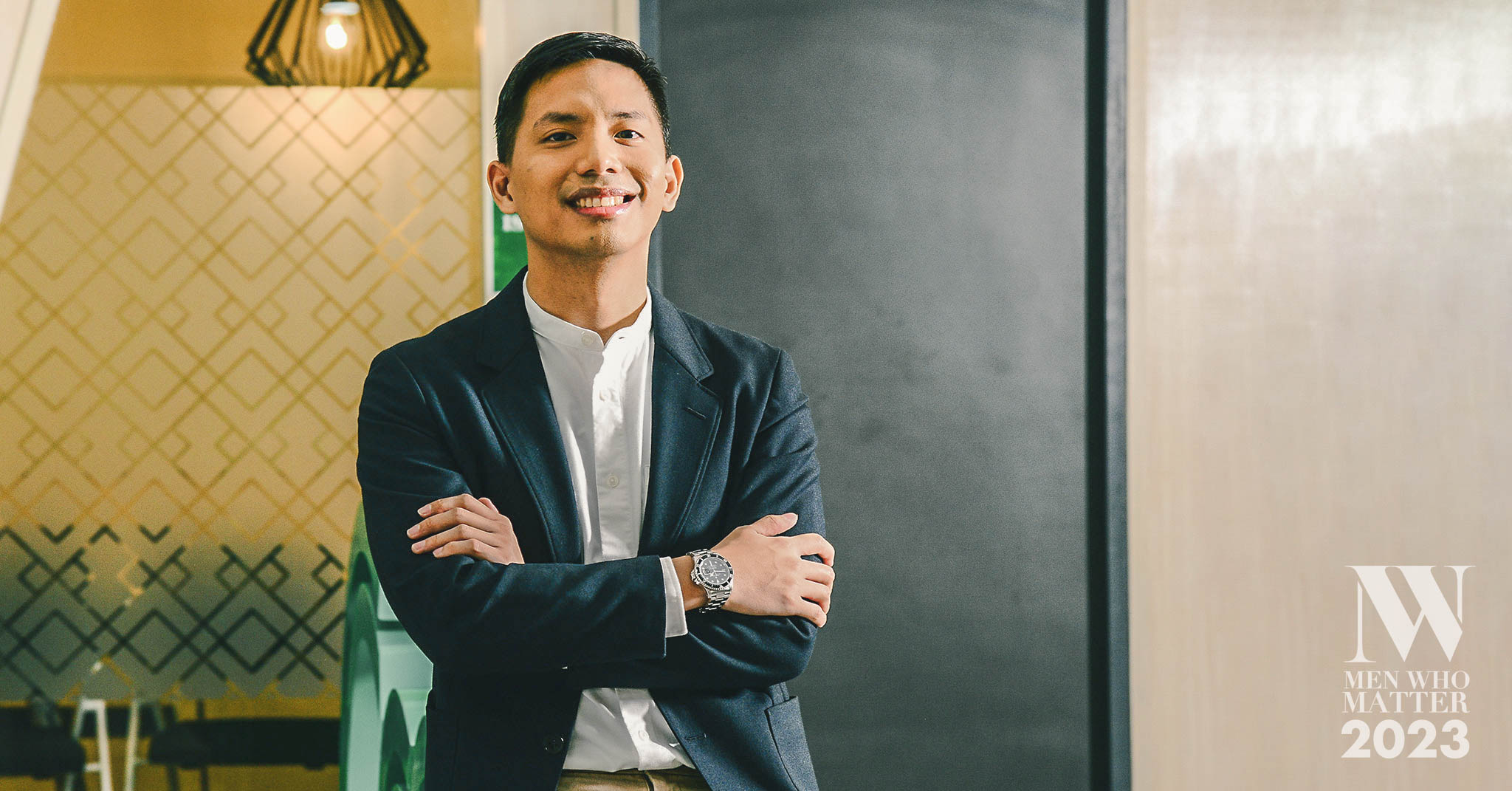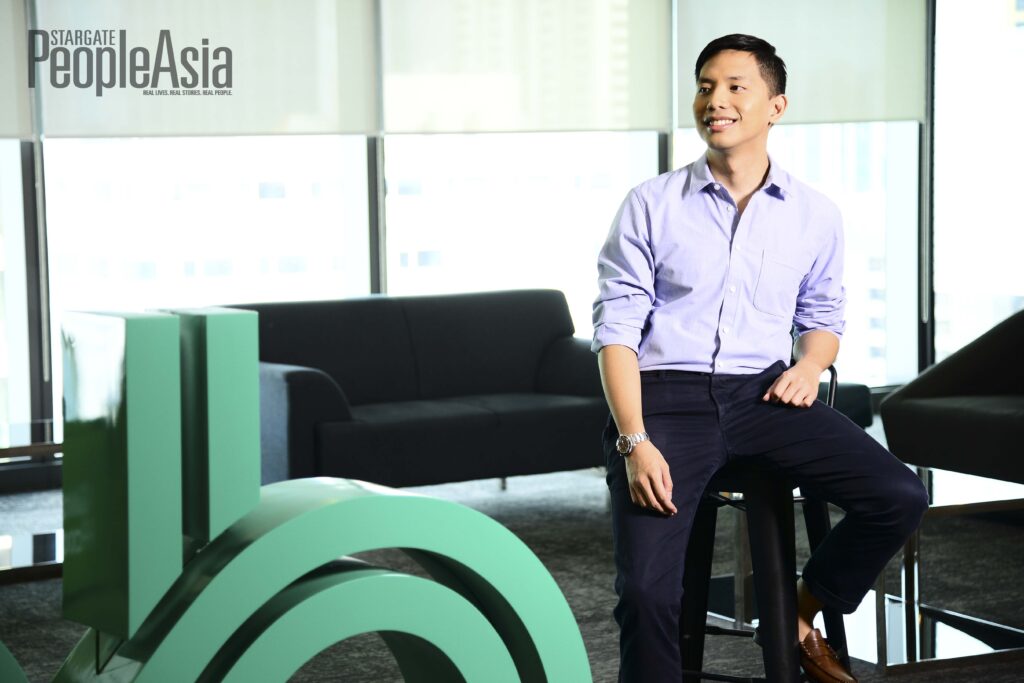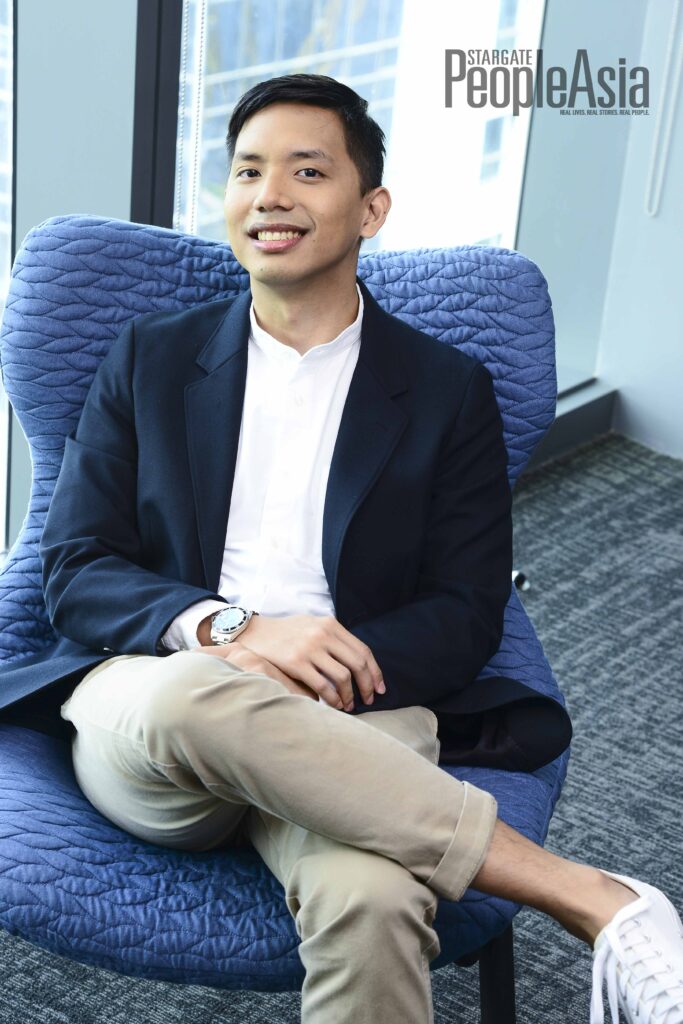He delivers on his deliverables. And on his advocacy to work hard on a job that is an advocacy as well.
By JOANNE RAE M. RAMIREZ
Photography by MJ SUAYAN
Trust comes when you deliver on your promises in the best way you can. Meet someone who makes delivery his business and his mission statement — Greg Camacho, director for deliveries of Grab Philippines. This includes GrabFood, GrabMart and GrabKitchen.
As far back as he can remember, 34-year-old Greg Camacho has tried to seize — or shall we say, grab — the day, in order to make a difference in this world. After all, he had to keep up with several luminaries in the family, like his grandmother Leonarda Camacho, for one. She was an eco-warrior long before women took up the environment as a cause, planting 10 million trees in her lifetime. His father Teodoro IV (BoyC) grew a family business and sent his siblings to school after losing their father when he was only 24. His mother Tetchy balanced a career and motherhood, and raised sons who graduated with academic honors. “My parents are my biggest influence,” he says.
His uncle Lito is a former finance secretary. The list of achievers in the Camacho family is long, and Greg knew early in life that he had the genes, the tools and the motivation to be on that list, too. And deliver.
“I was surrounded by a really brilliant family. And so, I think growing up, my dream was just to also leave a mark in any way that I could. I didn’t know how exactly, but I just wanted to, at that point, do something important and helpful.”
Prior to joining Grab, Greg had a high-flying career in tech and finance. This former La Sallian (high school, graduating valedictorian) and Atenean (college, with honors) has a Master of Business Administration from Oxford University’s Said Business School, graduating with distinction in 2016. He is also a Chartered Financial Analyst Charterholder.
After his fulfilling stint in the world of finance, he decided to go corporate. He wanted to solve the traffic problem, so he applied at Uber, which unfortunately, did not have an opening at the time. In hindsight, he considers it a blessing in disguise. He was asked if he wanted to join Uber Eats instead, which he had not heard of. “I honestly had no idea what it was, because food delivery was not the thing back then. But, I decided to roll the dice.”
The roll of the dice didn’t immediately turn out in his favor because three months later, just as Greg and his team were about to launch Uber Eats, Grab took over Uber’s operations in Southeast Asia. After considering many other offers, he decided to accept the one from Grab.
“Ultimately, the mission was always the same, right? I had said yes to Uber Eats because I want to help democratize food delivery. Food delivery, in the past, was the arena of big companies.” His idea was to enable the smaller merchants to have access to a delivery service as well.
“That was really the driving mission. The logo, you know, changed from black to green, but at the end of the day, it’s still what we had set out to do so. And so, we all agreed to join,” Greg recalls.
His passion for supporting homegrown start-ups and MSMEs reportedly propelled Grab’s delivery service “to be the most preferred online food and everyday essentials platform in the Philippines.”
He remembers how this once seemed undeliverable.
When GrabFood first launched, it had about 40 to 50 merchants. On the first day, the app had seven orders, five of which came from the Grab team itself.
“I remember this one time when we were on our way to pitching to one of our earlier merchants. I was telling EJ dela Vega, who now leads mobility for Grab, ‘Hey, man, wouldn’t it be so cool in the future if you look out your car window and you’d see riders in green?’ Because at the time, delivery wasn’t really a big deal. And it’s so interesting now, because I can never go out of the house without seeing a Grab delivery rider on the road. There was a time when this was, you know, this seemed like a very impossible thing.”
And then came the unprecedented. The pandemic was a giant roadblock that no one knew how to surmount. “We didn’t know what was going to happen. People were not allowed to go out, so how would delivery riders be going out when everyone was stuck at home?”
After a decision by the leadership team to shut down the app on the day the March 2020 lockdown was announced, the team found itself reversing its decision the following day.
“At around 10 a.m., we started seeing reports that delivery riders were actually being allowed to move around. So right then and there, we turned (the app) back on,” says Greg. “And you know, that very first day was crazy because our demand doubled overnight. But our delivery riders overnight got cut in half because a lot of them live in the outskirts of Metro Manila. No one could come in. So, imagine a situation where your demand doubled, but you had half your riders. It was a very tumultuous time. But again, with hard work, and with the team — I have a very great team, and I’m very proud of them — you’re able to get across it.”
How did Grab ride out the pandemic?
By not getting overwhelmed by the highway less traveled and by hurdling one hump at a time, says Greg.
“I always tell the team that we should always break down problems into smaller bits and pieces. And that’s what we did. We cut up the problem into different bits. We looked at the delivery partners — how are we going to ensure that they were safe? How are you going to get more of them out on the road? How are we going to provide for them during this difficult time?
“On the merchant side, we talked about how could we support our merchants. How could we make sure that in terms of cash flows, they’re well equipped to ride out the pandemic? And then for the consumers, how could we ensure reliability? How could we give offerings that were relevant and mattered to them at the time? So that’s really how we did it. We just cut the bigger problem into bite-sized pieces, and then we did initiatives for each.”
Bite-sized problems are indeed easier to chew.
“We started seeing the numbers go up, because I think at some point, people had gotten used to the idea of the lockdown and living with the lockdown. Fortunately for us, GrabFood had become a part of the new normal at the time.”
Grab Deliveries now has “tens of thousands” of merchants — from an original 40 to 50.
“It has become a normal part of people’s lives. Based on our surveys, and even for restaurants, eight in 10 believe that deliveries are something essential for survival. But that doesn’t stop there. We have to continue to evolve,” he adds.
“Now, the challenge, or the opportunity, is, how do we future-proof the business moving forward for our merchant partners? We want to expand beyond deliveries to other consumer touchpoints. Because whenever there are consumers and there are restaurants to serve, we want to be there helping them out.”
Greg feels he not only has deliverables as a corporate executive, but as a Filipino.
“The reason why I continue to work hard and stay with the company is because there is a lot of value creation. We work hard to make sure that our delivery partners have a viable alternative means of living that’s sustainable. Also, for the MSMEs. I think, 99.51 percent of all companies in the Philippines are MSMEs. How do we enable them? How do you get more of them? How do we provide more jobs to the staff? It’s a very important part of why we do what we do,” says Greg.
Grabbing the day for him and making it count means he also has a life outside work. Greg, a bachelor, spins as a DJ and also enjoys basketball and biking.
In his own words
Purpose-driven and mission-oriented, Greg Camacho tells PeopleAsia what keeps him going as a business leader.
ON CHAMPIONING MSMEs:
We at Grab continue to innovate business models and create new tools to serve even the smallest entrepreneur. We also give them access to much-needed capital which they can use to expand their businesses. Accessible financing allows us to help MSMEs scale and be more flexible amid rising headwinds like inflation.
We are also dedicated to democratizing access to digital tools. I find this to be among the greatest disruptions that online marketplaces have brought upon the industry. With Grab, Digital solutions are no longer exclusive to the big players.
ON GRABBING OPPORTUNITIES:
The main opportunity for Grab Deliveries right now is its expansion to other cities in the Philippines. By penetrating and serving these cities, we can directly enable livelihood generation and invigorate their local economies as we offer our safe, reliable and affordable services to more Filipinos.
ON VISION:
My vision for Grab Deliveries is to continue being the leading deliveries platform and to set the direction where the industry should be headed in order to serve our stakeholders in the best possible way. We continue to innovate to offer the best possible customer experience. We are also dedicated to ensuring that our driver-partners continue to enjoy viable livelihood opportunities on our platform, particularly in this time where we are observing economic headwinds. And lastly, we are committed to leading the march for environmental sustainability within the industry.
Grooming by EDDIE MAR CABILTES







